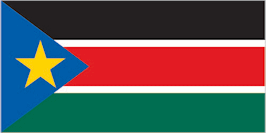South Sudan - People
 South Sudan is composed of more than 200 ethnic groups, with different languages. Official languages were Arabic and English, though on independence English became the official language. The vast majority of people in the South practice traditional and/or indigenous beliefs while a substantial amount follow Christian-based practices.
South Sudan is composed of more than 200 ethnic groups, with different languages. Official languages were Arabic and English, though on independence English became the official language. The vast majority of people in the South practice traditional and/or indigenous beliefs while a substantial amount follow Christian-based practices.
Sudan’s population is young, with an estimated 40% being under the age of 15 years (EU Commission 2011) and natural population growth is significant, resulting in a young demographic profile, with 62.2% of the population under 25 years old (IOM 2011). The populatin has doubled in less than two decades, from about 5 million in 1995 to over 11.5 million by 2014. Average household size is 8 (7.5 in 2008) ranging from 6 in the hills zone and 11.5 in the Eastern Flood plains zone (WFP 2010). On average, one out of every three households has a chronically ill family member (WFP 2010) who could not work more than 3 of the last previous 12 months.
The year 2012 saw the arrival of refugees fleeing to South Sudan as a result of ongoing violence in Blue Nile and South Kordofan states in Sudan. While at the beginning of 2012 humanitarian partners had planned for 80,000 new arrivals, this number had to be revised upwards when more than 112,000 people crossed the border to seek refuge between April and July alone. As of December 2012, according to UNHCR, there were 170,000 refugees from Sudan in South Sudan.
After enduring two decades of civil war, the people of South Sudan have one of the lowest literacy rates in the world (in 2010, only 27 percent of the adult population could read and write, according to South Sudan’s National Bureau of Statistics). Education consistently leads the list of government services that are most highly valued and desired by the public—demonstrating that South Sudanese see a better education for their children as a top priority.
South Sudan also faces a severe challenge in terms of human capital—shortfalls in the number of educated and trained workers needed to run the government of the new country. The literacy rate is even lower among women, so USAID is providing scholarships to help girls enroll and remain in school, and training opportunities for women, including teacher training. South Sudan also faces the challenge of integrating into productive employment hundreds of thousands of recent returnees who have come back to their ancestral home areas after years or decades living in northern Sudan. Since October 30, 2010, more than 370,000 Sudanese have returned to South Sudan and the Three Areas—the Abyei Area and Southern Kordofan and Blue Nile states.
South Sudan has a shortage of both skilled and unskilled workers across most areas in the formal sector. According to the 2008 census, 84 percent of those employed are in non-wage work. Three out of five children joined the labor force by age 10, largely through cattle herding or subsistence farming. Unskilled labor in the service and construction sectors is often performed by immigrants from neighboring companies.
Without reliable access to employment or education opportunities, youth in zones of high conflict remain caught in a culture of war, accustomed to cattle raiding and banditry as one of the few economic opportunities available.
As South Sudan recovers from decades of civil war, the vast majority of the population of the new nation lacks access to essential health services and to safe water and sanitation. These conditions contribute to poor health for the people of South Sudan and exceptionally high mortality rates, particularly of mothers, infants and children. The maternal mortality ratio is among the highest in the world, and one in every 10 infants will die before his or her fifth birthday. Malaria is a major cause of death among the general population, particularly for children under age 5 and pregnant women. HIV/AIDS, already prevalent in East Africa, has the potential to become a serious threat in South Sudan.
Recognizing that many South Sudanese were falling ill or dying from preventable or treatable causes, the Ministry of Health identified a set of priority health care actions and interventions proven to most efficiently and effectively reduce mortality, disability and morbidity due to the most common health problems. This basic package of health and nutrition services is comprised of interventions for disease prevention, health promotion and selected curative care that can be delivered cost-effectively with available technology.
Preliminary data indicates that approximately 3 percent of South Sudan’s population is HIV-positive. With internal and cross-border trade commencing, all the risk factors for an increase in HIV infections are present, with sex workers, truck drivers, motorcycle riders and soldiers among the groups considered to be most at risk of HIV infection. Tuberculosis (TB) is a major cause of morbidity and mortality in South Sudan, with the total number of TB patients estimated at 5,688 per 100,000 and mortality reported to be 1,652 per 100,000
|
NEWSLETTER
|
| Join the GlobalSecurity.org mailing list |
|
|
|


